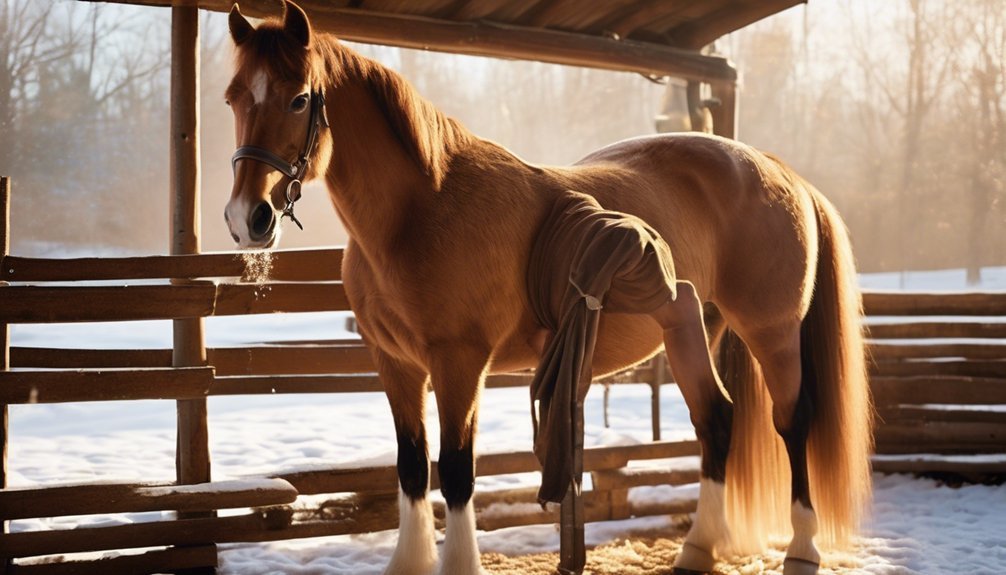
Maintaining your horse's coat during cold weather requires a thoughtful approach. You need to consider grooming, nutrition, and shelter to keep your horse comfortable and healthy. Regular brushing is vital for removing dirt and promoting shine, while a balanced diet supports hair growth. Additionally, understanding your horse's needs in winter can prevent common issues. If you're unsure where to start, let's explore the essential steps to keep your horse looking its best despite the chill.
Key Takeaways
- Ensure adequate shelter to protect your horse from wind and moisture while allowing their coat to insulate naturally.
- Regularly groom your horse to prevent matting, promote circulation, and enhance coat shine.
- Use appropriate grooming tools, like rubber curry combs and shedding tools, to maintain coat health and appearance.
- Limit bathing to once a month using lukewarm water, and ensure your horse is thoroughly dried afterward to prevent chills.
- Provide a balanced diet rich in fatty acids and adequate hydration to support coat health during cold weather.
Understanding the Impact of Cold Weather on Your Horse's Coat
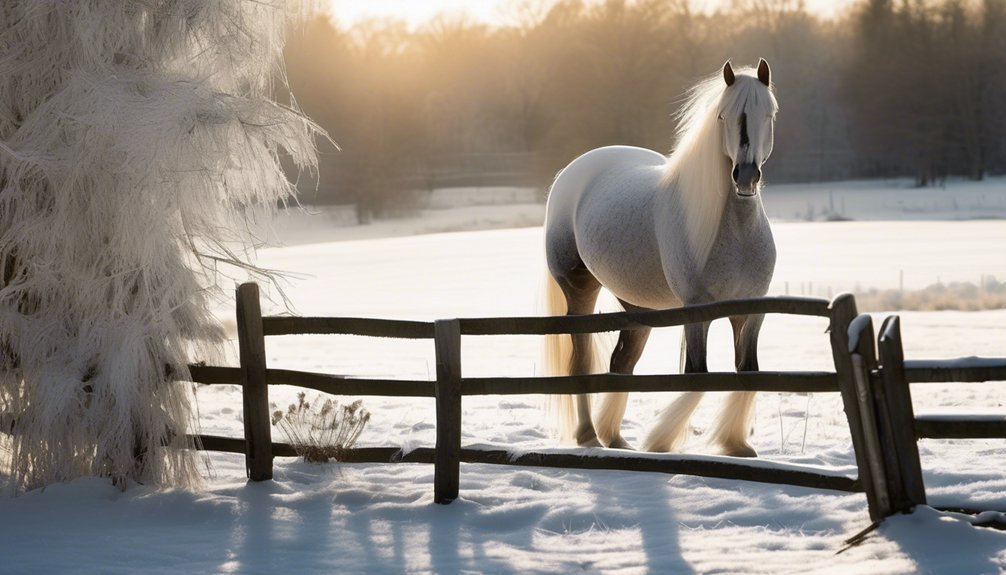
As the temperatures drop, your horse's coat undergoes significant changes to adapt to the colder environment.
You'll notice that the hair becomes thicker and coarser, providing essential coat insulation against harsh weather. This natural response is vital; it helps trap warmth close to your horse's body, reducing the cold weather effects on their health.
The longer guard hairs stand upright, creating a protective layer that shields against wind and moisture.
It's important to remember that while this insulation is crucial, it can also lead to overheating if your horse is too heavily blanketed.
Keep an eye on your horse's comfort, ensuring they've adequate shelter and protection while allowing their coat to serve its purpose effectively.
Importance of Regular Grooming
While it may be tempting to skip grooming during the cold months, regular grooming is essential for maintaining your horse's coat and overall health. Consistent grooming helps prevent matting and promotes circulation, ensuring your horse stays comfortable.
Here are some key benefits of maintaining a grooming frequency during winter:
- Removes dirt and debris: Keeps the coat clean and healthy.
- Stimulates natural oils: Enhances coat shine and insulation.
- Checks for skin issues: Early detection of irritations or parasites.
- Strengthens your bond: Builds trust and communication with your horse.
Choose the right brush types for different areas of your horse's body to maximize effectiveness.
Your dedication to grooming will ensure your horse's coat remains in top condition, even in the cold.
Choosing the Right Grooming Tools
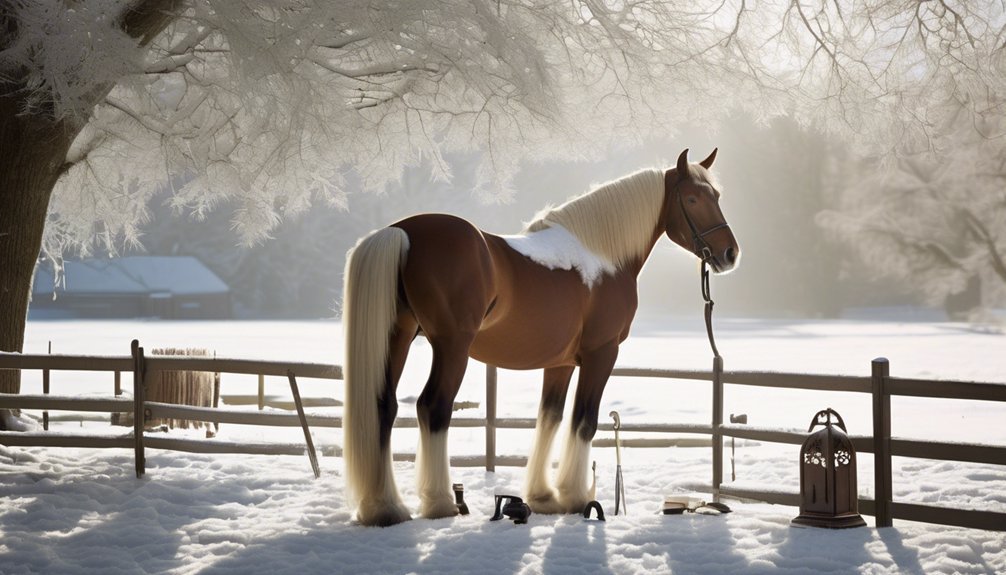
When it comes to grooming your horse during the cold months, selecting the right tools is essential for maintaining their coat and skin health. The right grooming brushes help distribute natural oils, while shedding tools effectively remove loose hair. Here's a handy guide to help you choose wisely:
| Tool Type | Purpose | Recommended Use |
|---|---|---|
| Grooming Brush | Distributes oils and dirt removal | Daily grooming routine |
| Shedding Tool | Removes loose winter coat | Seasonal shedding |
| Rubber Curry Comb | Stimulates skin and promotes circulation | Before brushing |
| Mane Comb | Untangles mane and tail | As needed |
Investing in quality grooming tools not only enhances your horse's appearance but also strengthens your bond. Happy grooming!
Bathing Your Horse in Winter
Bathing your horse in winter can be a challenge, but with the right approach, it's doable and beneficial for their coat and skin.
When winter bathing, keep these tips in mind:
- Water Temperature: Use lukewarm water to avoid shocking their skin.
- Bathing Frequency: Limit baths to once a month to prevent skin sensitivity and dryness.
- Coat Drying: Dry your horse thoroughly post-bath to prevent chills; consider using a fleece cooler.
- Grooming Techniques: Incorporate gentle grooming before and after bathing to stimulate skin health and distribute natural oils.
Nutrition for a Healthy Coat
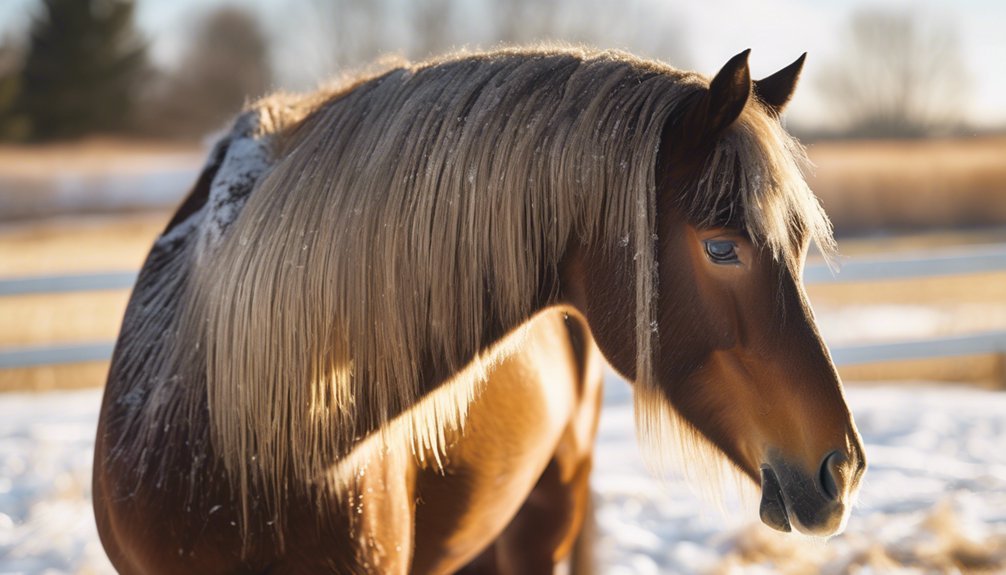
To ensure your horse's coat remains healthy and shiny during cold weather, it's crucial to focus on their nutrition. A balanced diet rich in essential fatty acids, vitamins, and minerals is key.
Consider incorporating dietary supplements specifically designed for coat conditioning. Omega-3 and Omega-6 fatty acids, often found in flaxseed or fish oil, can work wonders for skin health and coat shine.
Additionally, ensure your horse receives adequate protein to support hair growth and overall vitality. Don't forget about antioxidants, which can help combat oxidative stress during colder months.
Hydration and Its Role in Coat Health
While you might focus on feed and grooming, hydration plays a crucial role in maintaining your horse's coat health during cold weather.
Ensuring your horse has adequate hydration sources is essential for achieving a moisture balance in their skin, which directly impacts coat quality.
Here are some practical tips to keep in mind:
- Offer fresh, clean water daily.
- Encourage hydration with soaked hay or beet pulp.
- Monitor their urine output to assess hydration levels.
- Consider electrolyte supplements during particularly dry spells.
The Benefits of Blanketing
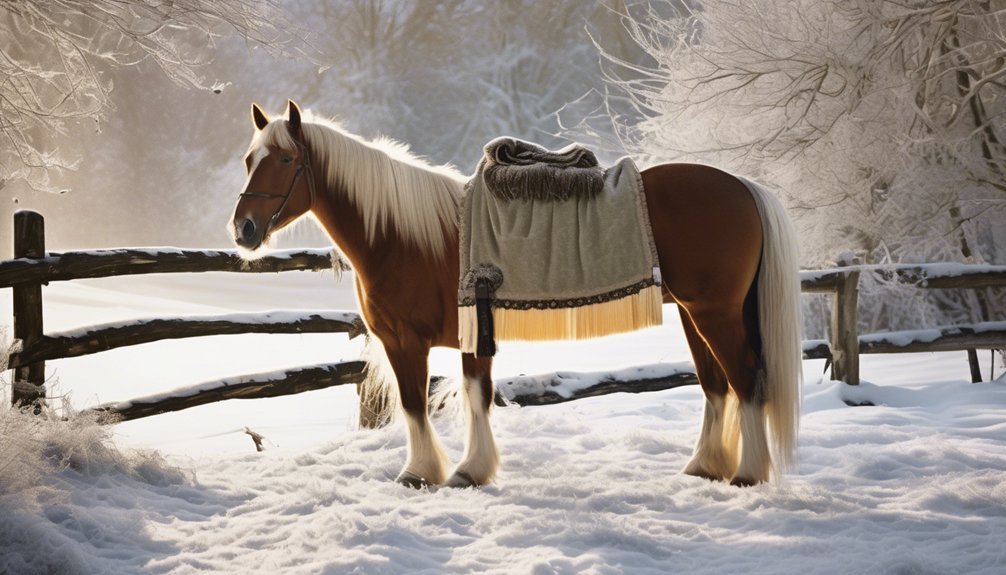
When temperatures drop, blanketing your horse becomes an essential part of their winter care routine. Choosing the right blanket types—like stable blankets, turnout blankets, and sheet blankets—ensures your horse stays warm and comfortable. Each type serves a specific purpose, so understanding their features is crucial.
Proper blanket fitting is just as important; a well-fitted blanket prevents rubbing and allows for freedom of movement. Make sure the blanket covers your horse's body adequately without being too tight or too loose.
Regularly check for any signs of discomfort or shifting. By providing the right blanket, you not only protect your horse from the cold but also help maintain their coat's health, ensuring they look and feel their best during harsh winter months.
Monitoring for Skin Issues
Monitoring your horse's skin health during cold weather is crucial for preventing potential issues that can arise from harsh conditions.
Regular skin inspections help you catch dermatological issues early. Here are some signs to watch for:
- Dryness or Flakiness: Indicates possible moisture loss.
- Redness or Inflammation: Could signal an allergic reaction or irritation.
- Bumps or Lesions: May suggest infections or parasites.
- Unusual Shedding: Can point to underlying health concerns.
Seasonal Coat Changes and Care
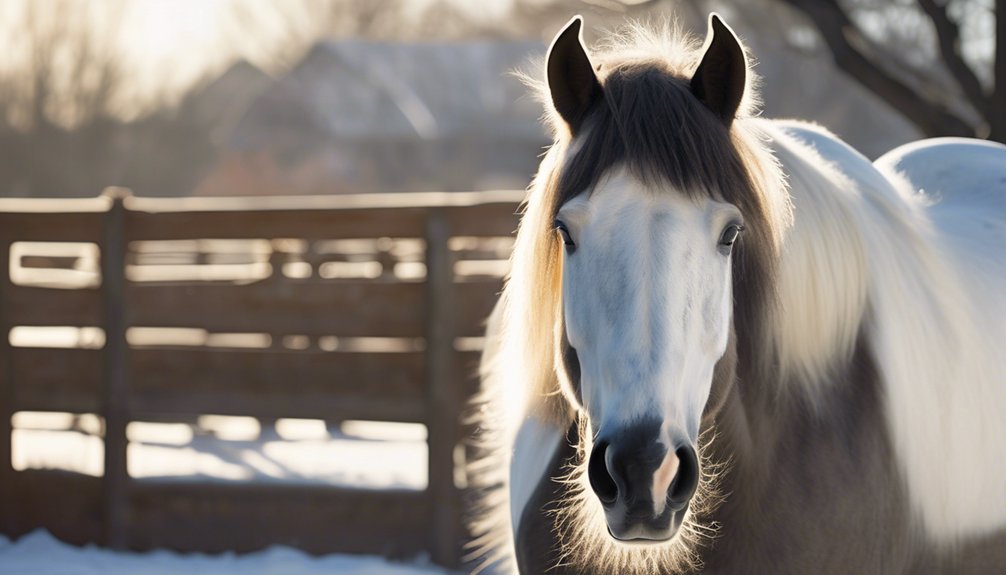
As temperatures drop and daylight decreases, your horse undergoes significant seasonal coat changes that require attentive care. You'll notice increased coat thickness and a shift in texture. During this time, monitor for seasonal shedding, which can occur as your horse transitions into its winter coat.
Here's a helpful guide to understand these changes:
| Coat Phase | Care Tips |
|---|---|
| Early Fall | Groom regularly to remove loose hair. |
| Late Fall | Check for parasites, as they can affect coat quality. |
| Winter | Use blankets if needed, but allow natural insulation. |
| Early Spring | Help with shedding using a shedding tool. |
Frequently Asked Questions
Can I Use Human Shampoo on My Horse's Coat?
Using human shampoo on your horse's coat isn't ideal. It can disrupt natural oils and lead to dryness. For proper horse coat care, stick to products specifically formulated for equines to ensure optimal health and shine.
How Often Should I Clip My Horse's Coat in Winter?
You should follow a careful clipping schedule during winter grooming, ideally every four to six weeks. This keeps your horse comfortable and helps manage their coat as temperatures fluctuate, ensuring they stay healthy and happy.
What Are Signs of an Unhealthy Winter Coat?
If you notice a dull coat or excessive shedding, it's a sign your horse might be stressed or lacking proper nutrition. Pay attention to these signs, as they can indicate underlying health issues needing your care.
Can I Use a Hairdryer on My Horse's Coat?
You can use a hairdryer on your horse's coat, but ensure it's on a low setting for safety. Keep it at a distance to prevent overheating, helping with coat drying without causing discomfort.
Are There Supplements to Improve Coat Shine in Winter?
Yes, there are supplements that enhance coat shine during winter. Consider adding omega fatty acids and coat conditioning products to your horse's diet. Regular winter grooming also helps distribute natural oils, promoting a healthy, radiant coat.
Conclusion
Maintaining your horse's coat during cold weather isn't just about keeping it shiny; it's a blend of grooming, nutrition, and proper care. Regular brushing and a balanced diet are key, while hydration can't be overlooked. By understanding your horse's needs and monitoring for any skin issues, you'll ensure a healthy, resilient coat. Remember, the right shelter and thoughtful blanketing can make all the difference. With these strategies, you'll keep your horse looking and feeling its best all winter long.





